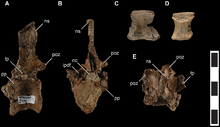Talos (dinosaur)
| Talos Temporal range: Campanian, 75.95Ma | |
|---|---|
 | |
| Articulated foot | |
| Scientific classification | |
| Kingdom: | Animalia |
| Phylum: | Chordata |
| Clade: | Dinosauria |
| Suborder: | Theropoda |
| Family: | †Troodontidae |
| Genus: | †Talos Zanno et al., 2011 |
| Species: | † T. sampsoni |
| Binomial name | |
| Talos sampsoni Zanno et al., 2011 | |
Talos is an extinct genus of carnivorous bird-like theropod dinosaur, an advanced troodontid which lived during the late Cretaceous period (late Campanian, about 75.95 Ma) in what is now Utah, USA.
Discovery

Talos is known only from the holotype specimen UMNH VP 19479, a partial postcranial skeleton of a subadult individual including the handlimbs, pelvis, vertebral fragments, chevrons and the left ulna. It was discovered and collected in 2008 by M. J. Knell during the Kaiparowits Basin Project, initiated by the University of Utah in 2000, from the Kaiparowits Formation within the Grand Staircase-Escalante National Monument. It was first named by Lindsay E. Zanno, David J. Varricchio, Patrick M. O'Connor, Alan L. Titus, and Michael J. Knell in 2011 and the type species is Talos sampsoni. The generic name comes from Talos, a giant bronze automaton in Greek mythology and is intended to be a pun on the English word talon. The specific name honors television paleontologist Dr. Scott D. Sampson for researching and collecting fossils during the Kaiparowits Basin Project.[1]
Description

Talos is approximately 2 metres (6.6 ft) in length, and its weight has been estimated at thirty-eight kilograms. Talos had a sickle claw. That of the specimen was damaged during life, possibly in an attack on prey.[1]
Talos was in 2011 assigned to the Troodontidae. A cladistic analysis indicated it formed a clade of derived troodontids together with Byronosaurus, Saurornithoides, Zanabazar and Troodon.[1]
Paleoecology

Habitat
The only known specimen of Talos was recovered at the Kaiparowits Formation, in southern Utah. Argon-argon radiometric dating indicates that the Kaiparowits Formation was deposited between 76.1 and 74.0 million years ago, during the Campanian stage of the Late Cretaceous period.[2][3] During the Late Cretaceous period, the site of the Kaiparowits Formation was located near the western shore of the Western Interior Seaway, a large inland sea that split North America into two landmasses, Laramidia to the west and Appalachia to the east. The plateau where dinosaurs lived was an ancient floodplain dominated by large channels and abundant wetland peat swamps, ponds and lakes, and was bordered by highlands. The climate was wet and humid, and supported an abundant and diverse range of organisms.[4] This formation contains one of the best and most continuous records of Late Cretaceous terrestrial life in the world.[5]
Paleofauna

Talos shared its paleoenvironment with theropods such as dromaeosaurids, ornithomimids like Ornithomimus velox, tyrannosaurids like Albertosaurus and Teratophoneus, armored ankylosaurids, the duckbilled hadrosaurs Parasaurolophus cyrtocristatus and Gryposaurus monumentensis, the ceratopsians Utahceratops gettyi, Nasutoceratops titusi and Kosmoceratops richardsoni and the oviraptorosaurian Hagryphus giganteus.[6] Paleofauna present in the Kaiparowits Formation included chondrichthyans (sharks and rays), frogs, salamanders, turtles, lizards and crocodilians. A variety of early mammals were present including multituberculates, marsupials, and insectivorans.[7]
References
- ↑ 1.0 1.1 1.2 Lindsay E. Zanno, David J. Varricchio, Patrick M. O'Connor, Alan L. Titus and Michael J. Knell (2011). "A new troodontid theropod, Talos sampsoni gen. et sp. nov., from the Upper Cretaceous Western Interior Basin of North America". PLoS ONE 9 (6): e24487. doi:10.1371/journal.pone.0024487. PMC 3176273. PMID 21949721.
- ↑ Roberts EM, Deino AL, Chan MA (2005) 40Ar/39Ar age of the Kaiparowits Formation, southern Utah, and correlation of contemporaneous Campanian strata and vertebrate faunas along the margin of the Western Interior Basin. Cretaceous Res 26: 307–318.
- ↑ Eaton, J.G., 2002. Multituberculate mammals from the Wahweap(Campanian, Aquilan) and Kaiparowits (Campanian, Judithian)formations, within and near Grand Staircase-Escalante NationalMonument, southern Utah. Miscellaneous Publication 02-4, UtahGeological Survey, 66 pp.
- ↑ Titus, Alan L. and Mark A. Loewen (editors). At the Top of the Grand Staircase: The Late Cretaceous of Southern Utah. 2013. Indiana University Press. Hardbound: 634 pp.
- ↑ Clinton, William. "Preisdential Proclamation: Establishment of the Grand Staircase-Escalante National Monument". September 18, 1996. Retrieved 9 November 2013.
- ↑ Zanno, Lindsay E.; Sampson, Scott D. (2005). "A new oviraptorosaur (Theropoda; Maniraptora) from the Late Cretaceous (Campanian) of Utah". Journal of Vertebrate Paleontology 25 (4): 897–904. doi:10.1671/0272-4634(2005)025[0897:ANOTMF]2.0.CO;2.
- ↑ Eaton, Jeffrey G.; Cifelli, Richard L.; Hutchinson, J. Howard; Kirkland, James I.; Parrish, J. Michael (1999). "Cretaceous vertebrate faunas from the Kaiparowits Plateau, south-central Utah". In Gillete, David D. (ed.). Vertebrate Paleontology in Utah. Miscellaneous Publication 99-1. Salt Lake City: Utah Geological Survey. pp. 345–353. ISBN 1-55791-634-9.